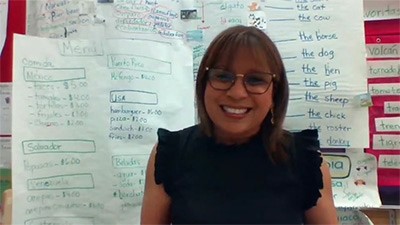Choose play for multilingual children: Bring joyful learning into your PreK-3 classroom

By Tricia Blanco
A growing body of research recommends that children in PreK-3 settings have more opportunities to engage in joyful learning to support their development and learning. This rings true for our young multilingual learners too! We were curious about educators of multilingual learners and the incorporation of play into their classrooms. So, we asked educators why they choose play and how they bring it to life in their teaching and learning practices.
Through our collaboration with PreK-3 educators, we discovered that the classroom, both indoors and out, is an ideal place to incorporate play for learning for the multilingual children you serve. Learn from experts in the field — educators who choose play — why they do so and how you, too, can bring joyful learning into your classroom or school.
Why choose play
“I choose play for learning with multilingual children because play is instinctive, and they all do it.”
– Kerith Tait, K-5 teacher, Madison, WI
Reasons educators choose play for multilingual children
- Play is powerful. Play, like language, is a child's meaning-making tool. Play affords time and space for children to activate their curiosity and language, explore and experiment, and learn with and from their peers. Simply put, play is learning.
- Play promotes interaction. Children interact with each other in authentic ways during play, providing them opportunities to develop their language and social-emotional skills (for example, problem solving, inviting others to play, taking turns, negotiating).
- Play is joyful and engaging. Children language and learn during activities that are varied, iterative, hands-on, engaging and joyful.
- Play is affirming. Play opens space for educators to affirm children’s identities, make learning relevant and responsive to children’s interests, experiences and cultural and linguistic practices.
Ready for More?
Choosing play for learning is one way you can promote and provide opportunities for multilingual children to language and learn. Look at our WIDA PreK-3 Essential Actions to consider other steps you can take to support the multilingual children you serve.
Bring joyful learning into your classroom
“Antes de nosotros jugar, nosotros investigamos y convertimos nuestro salón en un juego. ¿Quién lo creó? Los estudiantes; es un juego para ellos y creado por ellos y guiado por la maestra.”
– Zahide Marcano, kindergarten dual language one-way teacher, Elgin, IL
(Before we play, we investigate and turn our classroom into a play scenario. Who created it? The students; it is a play scenario for them, created by them and guided by the teacher.)
Ideas educators shared
- Reflect on your current beliefs, practices and resources. What do you know and believe about play? Are you already incorporating joyful learning into your classroom? If so, how? Are you considering children’s identities and their linguistic and cultural practices as you plan play? What is your role in the play? If you are not incorporating play, why not? How might you shift and grow your practice around play for learning?
- Learn from the multilingual children you serve. Observe their play; notice how they play, where, with what and with whom. Listen to their language interactions, consider their ideas and promote their agency. How can you build on their interests and assets through play?
- Explore your local context. Where is play already happening in your program or school? In your community? How do multilingual children play with their family and in their community?
- Collaborate with colleagues. Engage in professional learning around the characteristics and benefits of play. Co-design and co-develop play-based units and materials.
- Engage with children, families and community members to co-create play scenarios. Invite others into your classroom to join in the play.
- Play each day, each week, inside and outside, in all kinds of weather and yearlong.
Ready for More?
The National Association for the Education of Young Children(NAEYC) is a leading professional learning organization that offers many free resources for educators in PreK-3 settings. Here are NAEYC resources specifically focused on play. We suggest this brief article, Observing, Planning, Guiding: How an Intentional Teacher Meets Standards through Play, to get you started.
Advocate for play
“I think it's important that as educators, we give the word play its power, and as a right for children.”
– Julia Peterson, 4K teacher, Madison, WI
How educators advocate for play for multilingual children
- Give play its power. Be intentional about using the word play, for example, “play centers or play stations.”
- Make play visible. Highlight classroom play scenarios and the learning happening there in your communication with families, colleagues and administrators.
- Inform and include families. Share the characteristics and benefits of play with families. Explain why and how you incorporate joyful learning into your classroom. Invite families to engage in joyful learning in your classroom in ways they are comfortable.
- Engage in conversations. Talk with colleagues and administrators about your interest in play. Listen to and consider their ideas and concerns. Problem-solve together to find ways to incorporate play into your classroom.
- Extend joyful learning beyond your classroom. For example, co-create a tinkering or makerspace, or outdoor play space. Host a dramatic story telling or game night.
Ready for more?
WIDA’s Self-Paced Workshop – Let’s Play! Multilingual Children’s Joyful Learning in PreK-3 – offers more opportunities to learn from multilingual children and their educators. Engage with the educators featured in this article, and others, to identify additional characteristics and benefits of joyful learning, and to consider various ways in which to incorporate play for learning into your teaching practices and advocate for play in your local context.
*Note: Workshops available may vary by state.
About the Author
Tricia Blanco is a professional learning curriculum specialist on WIDA's Educator Learning, Research and Practice team. She engages in the research, development and facilitation of professional learning with educators of multilingual children and youth across the WIDA Consortium.





